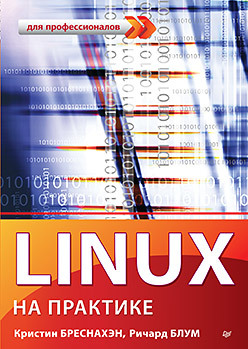The book "Linux in practice"
 The book is specifically designed to teach novice employees working with Linux. The main advantages of the book:
The book is specifically designed to teach novice employees working with Linux. The main advantages of the book:• contains thematically grouped lessons that quickly help you find the most necessary and go to a specific chapter where this topic is discussed in detail;
• describes the basics of the Linux operating system, including its distributions, types of open source applications, free software, licensing, navigation, and more;
• explores work with the command line, including navigation in it, turning commands into scripts, etc .;
• Learn to create user types and user groups.
Who needs to read this book
You were probably told to read this book as part of the course you are taking, but if this is not the case, you can use it to study Linux yourself or as an addition to other resources. If you are not familiar with Linux, then in this book you will find the necessary material for mastering the basic knowledge of this operating system. You can read this book, even if you have never used Linux before. If you already have some idea of this system, then many of the topics described here will be familiar to you.
')
Book structure
This book consists of an introduction and 15 chapters.
Chapter 1. Choosing an operating system. Provides an overview of operating systems. The material in this chapter will help you understand what Linux is and in what situations it may be useful to you.
Chapter 2. Software licensing. It describes the copyright law and licenses used by Linux and other operating systems to extend or restrict users' rights to use and copy software.
Chapter 3. Principles and philosophy of Linux. It provides a history of Linux, and describes how to use this and other operating systems.
Chapter 4. Popular Linux programs. We consider the main categories of Linux software and the most popular programs of this operating system.
Chapter 5. Hardware Management. Provides guidance on choosing and using hardware in Linux. It covers various topics, starting with the central processor (CPU) and ending with device drivers.
Chapter 6. Familiarity with the command line. Describes how to manage Linux using input commands. Although this topic is difficult for many new users, managing Linux from the command line is important.
Chapter 7. Working with files and directories. Explains how to move, rename, delete and edit files. Directories are a special type of file, so they are also described in this chapter.
Chapter 8. Search, retrieve and archive data. It discusses the tools you can use to search for data on your computer, as well as ways to manage archive files for transferring and backing up data.
Chapter 9. Processes and their data. Describes how to install programs on Linux, as well as changing the priority of starting or stopping the execution of individual programs.
Chapter 10. Editing Files. Dedicated to editing text files. It describes the basic text editors pico, nano and vi, as well as some common conventions for configuration files and text file formatting.
Chapter 11. Scripting. It describes the process of creating simple scripts, which are programs that can run other programs. You can use scripts to automate tedious tasks performed in manual mode, thereby increasing your productivity.
Chapter 12. Security Basics. Concepts that are crucial to understanding the multi-user nature of Linux are explained. In addition, the superuser account used by the OS for most administrative tasks is described.
Chapter 13. Creating users and groups. It discusses software and procedures that can be used to create, modify, and delete accounts and groups that determine who can work on a computer.
Chapter 14. Setting up ownership and access rights. Describes how to control: which users can access files and how they can do it. Along with users and groups, possession and access rights allow you to control the security of your computer.
Chapter 15. Managing Network Connections. Dedicated to the important issue of a Linux message about how to use the network (including connectivity testing and basic network security measures).
The chapters are arranged in order of increasing complexity of the tasks and systems described in them. The beginning of the book provides background information about Linux and describes the development philosophy of this operating system. Subsequent chapters deal with such basic user tasks as moving files. The final chapters of the book are devoted to tasks that are of most interest to system administrators, such as account management and network configuration.
Each chapter begins by listing the topics described in it. At the end of each chapter you will find a summary briefly summarizing the material presented, as well as exercises and test questions.
About the authors
Christine Bresnahan , CompTIA Linux +, LPIC-1, Linux Essentials, started working with computers more than 30 years ago as a system administrator. Kristin is an Associate Professor at the Ivy Tech Community College, where she teaches Linux certification preparation courses as well as Python programming courses. She writes books and creates tutorials.
Richard Blum , CompTIA Linux +, LPIC-1, Linux Essentials, has been working in the IT industry for more than 25 years as a system and network administrator and has published many books on Linux and open source. Rich is an online instructor in Linux and web programming courses that are held at US colleges and universities. Rich spends his free time with his wife Barbara and two daughters, Katie Jane and Jessica.
»More information about the book can be found on the publisher's website.
» Table of Contents
» Excerpt
Other books on the subject:
» Linux command line. Complete Guide Author: W. Shots
» Inside Linux Device By: B. Ward
Linux. System Programming. 2nd ed. Author: R. Love
For Habrozhiteley 25% discount coupon - Linux
Source: https://habr.com/ru/post/322976/
All Articles